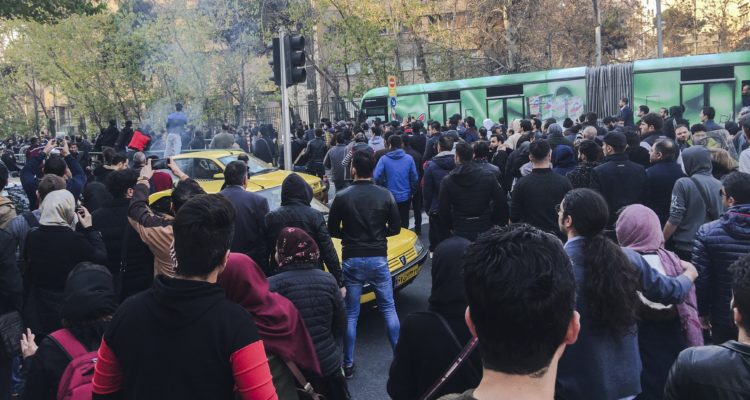Israeli observers note that calls for “regime change” have reverberated throughout Iran, where citizens have defied a government run by fanatical Islamic clerics.
By: Steve Leibowitz, World Israel News
It’s been only several days since widespread anti-government demonstrations erupted in Iran, but Israeli analysts are already calling the protests potentially more significant and already more widespread than anti-government disturbances in 2009.
The protests are challenging the nearly 40 year clerical-rule of the Islamic Republic in the largest disturbances since Iranian protests against the outcome of the 2009 presidential elections. The protesters are calling for “regime change” in a nation that wields considerable clout over much of the Middle East, including Syria, Lebanon, Yemen and Iraq.
The scattered protests focused on economic grievances in multiple Iranian cities, targeting alleged financial corruption, budget allocations for religious institutions and the bankruptcy of retirement funds. Some of the angriest demonstrations broke out in the cities of Mashhad, Kermanshah, Isfahan and even Qom, the bedrock of Shiite clerical rule. Protesters have included members of the middle class, student activists, working class dissidents and labor unionists.
The protesters are not calling for reform, instead demanding the resignation of Supreme Leader Ayatollah Ali Khamenei and President Hassan Rouhani.
Slogans of the protesters (translated into English) include: “We don’t want an Islamic Republic”; “Independence, Freedom, Iranian Republic”; “We are getting poor and clerics are driving fancy cars”; “We will die but we will take Iran back”; “Come out to the streets Iranians, shout for your rights”; “Death to the Revolutionary Guards”; and “Not Gaza, not Lebanon, my life for Iran.”
Poverty, crime, and repression, not election results
Menashe Amir has been working as an Israeli radio journalist broadcasting to Iran in Persian for over 52 years. Amir told World Israel News (WIN), “In 2009 nearly one million protesters were involved in Iranian protests, but this is different. Eight years ago the protests were over the falsifying of election results and the demonstrations were largely limited to the capital city of Tehran.
“This time it’s about poverty, food, crime in the streets and dictatorship. It’s also about the government wasting its resources on supporting the Syrian government and terrorist groups like Hezbollah and Hamas rather than dealing with the real problems of the people.” According to Amir, “Most significantly, back in 2009 protests were limited to Tehran and this time the demonstrations are taking place simultaneously in over 20 cities.”
Israel and the United States have been blamed by Iranian state-controlled media for stirring the unrest across Iran. Fars News Agency said that pro-regime demonstrators had warned against, “any kind of move masterminded by the anti-revolutionary forces and the US, British and Israeli spy agencies to stir unrest and dissidence in Iran.”
Protests have ‘nothing to do with Israel’
Meir Javedanfar is an Iranian-born Israeli Middle East commentator living in Israel. Javadanfan dismissed offhand Iranian charges that Israel is somehow involved in promoting the protests. He told WIN, “This has nothing to do with Israel. The Iranian regime always likes to find a scapegoat and to blame the real anger of the people on foreigners in order to divert attention and blame outsiders. This is not an Israeli issue. It’s a domestic Iranian issue.”
“The numbers of protesters are so far much less than in 2009, but the protests are more widespread. Back then the nucleus was in Teheran, but these protests are decentralized and leaderless. Teheran residents have mainly watched from the side until now, but that could change. Security forces are still holding back and have not put down the protests with extreme force. They were much quicker in 2009,” Javadan told WIN.
What do the protesters want? According to Javadanfan, “In terms of realistic goals of protesters this time, the message is that the people are demanding regime change. They want the rule by religious fanatics to end. The message thus far is that the people are angry because of the incompetence of those ruining the economy and the issues are social security, housing and other things relating to quality of life. But make no mistake; the protesters want change through regime change.”
Uprisings in Iran may die out because of a lack of leadership, clear organization and goals. If the protests persist, the regime could crack down harder on them, with live ammunition, mass arrests and military lockdowns. There is no indication that the Iranian regime is any less willing to violently crush these protests than it was when it crushed the 2009 protests. That means we are likely to see a frightening new round of bloodshed if the protests continue.
Speaking last month to the Saban Conference in Washington, Prime Minister Netanyahu said, “One day the Iranian regime will fall, Iranian mothers and fathers will rejoice in the streets and Israel will be the first in line to restore relations and rebuild our great partnership.”




